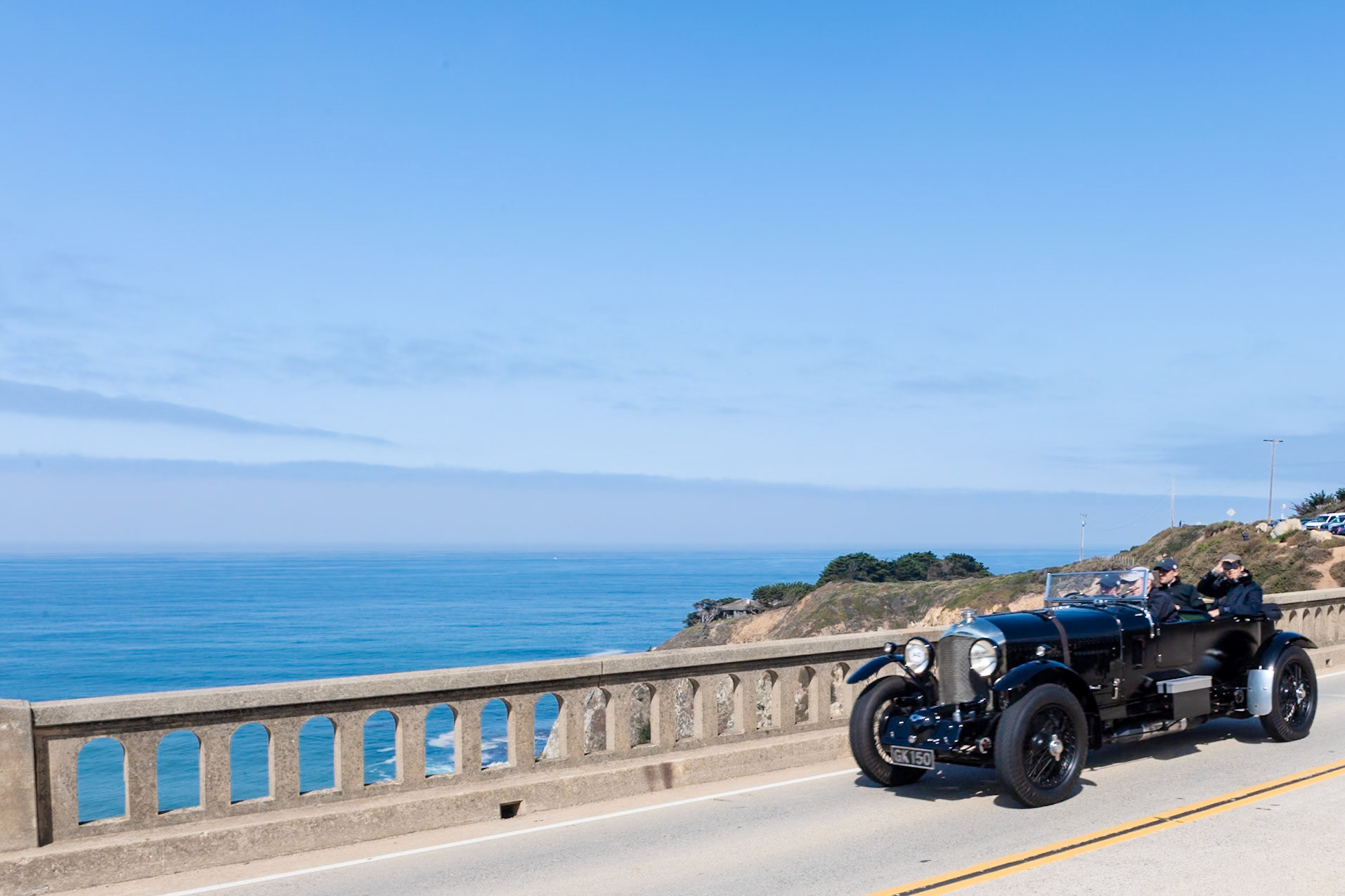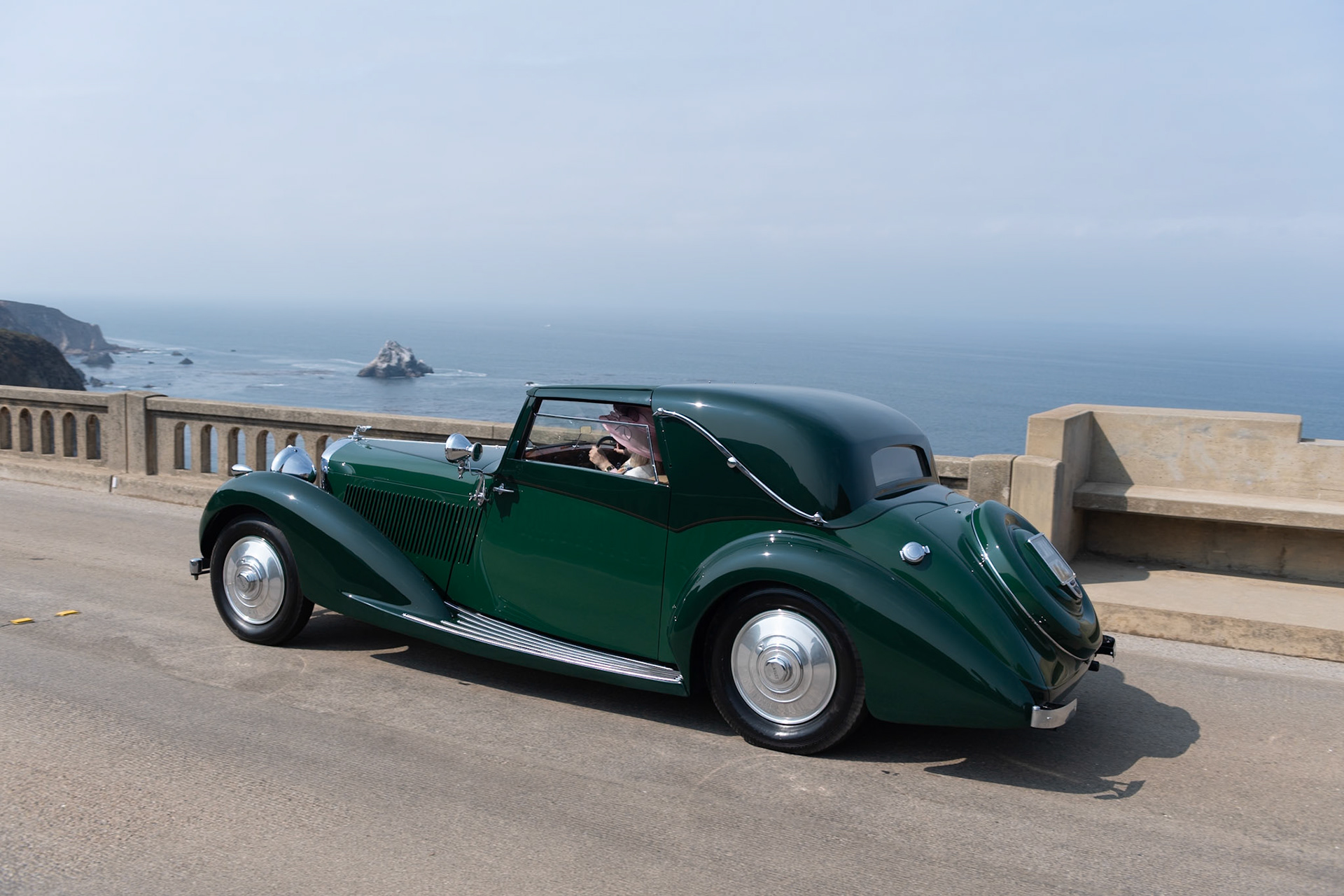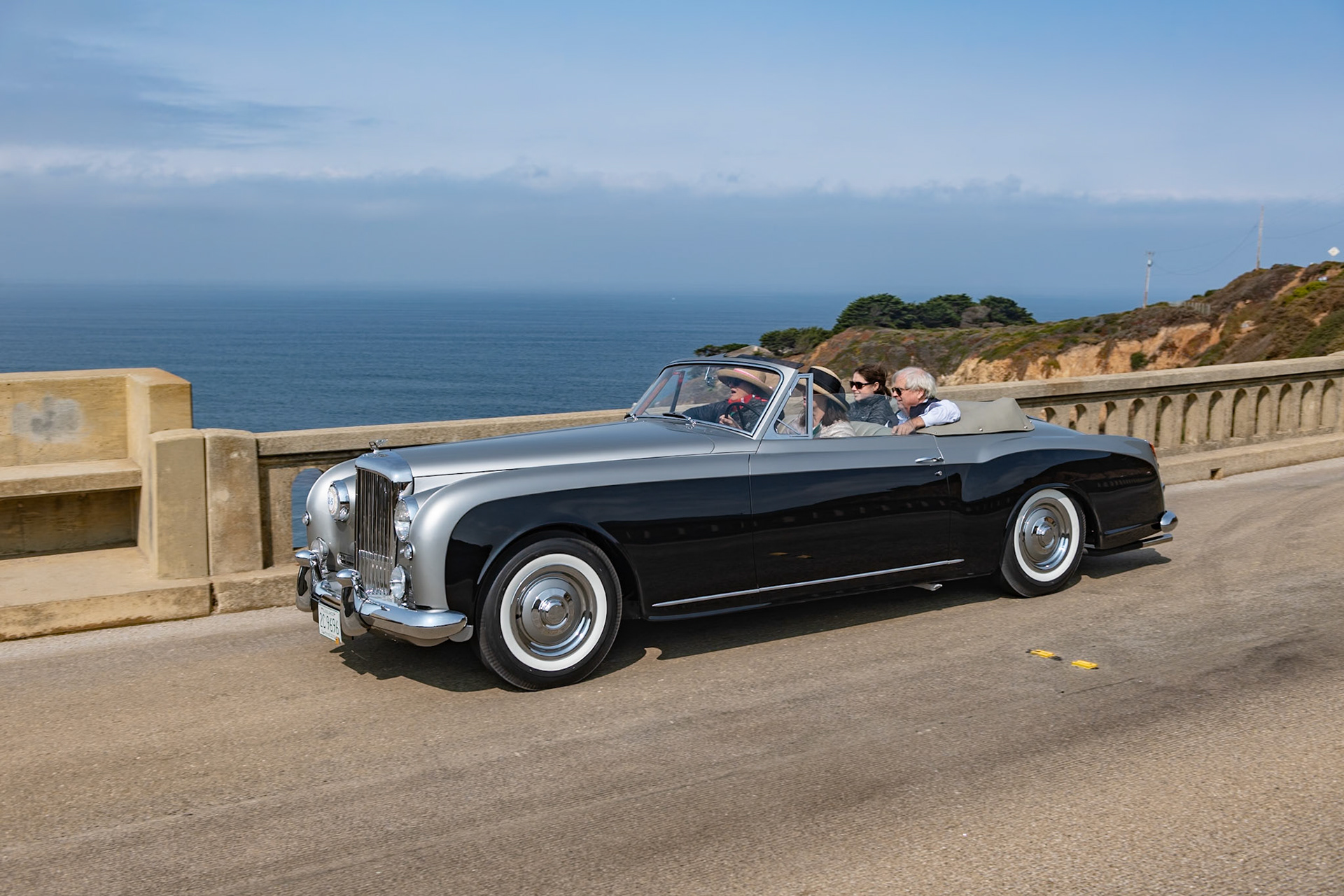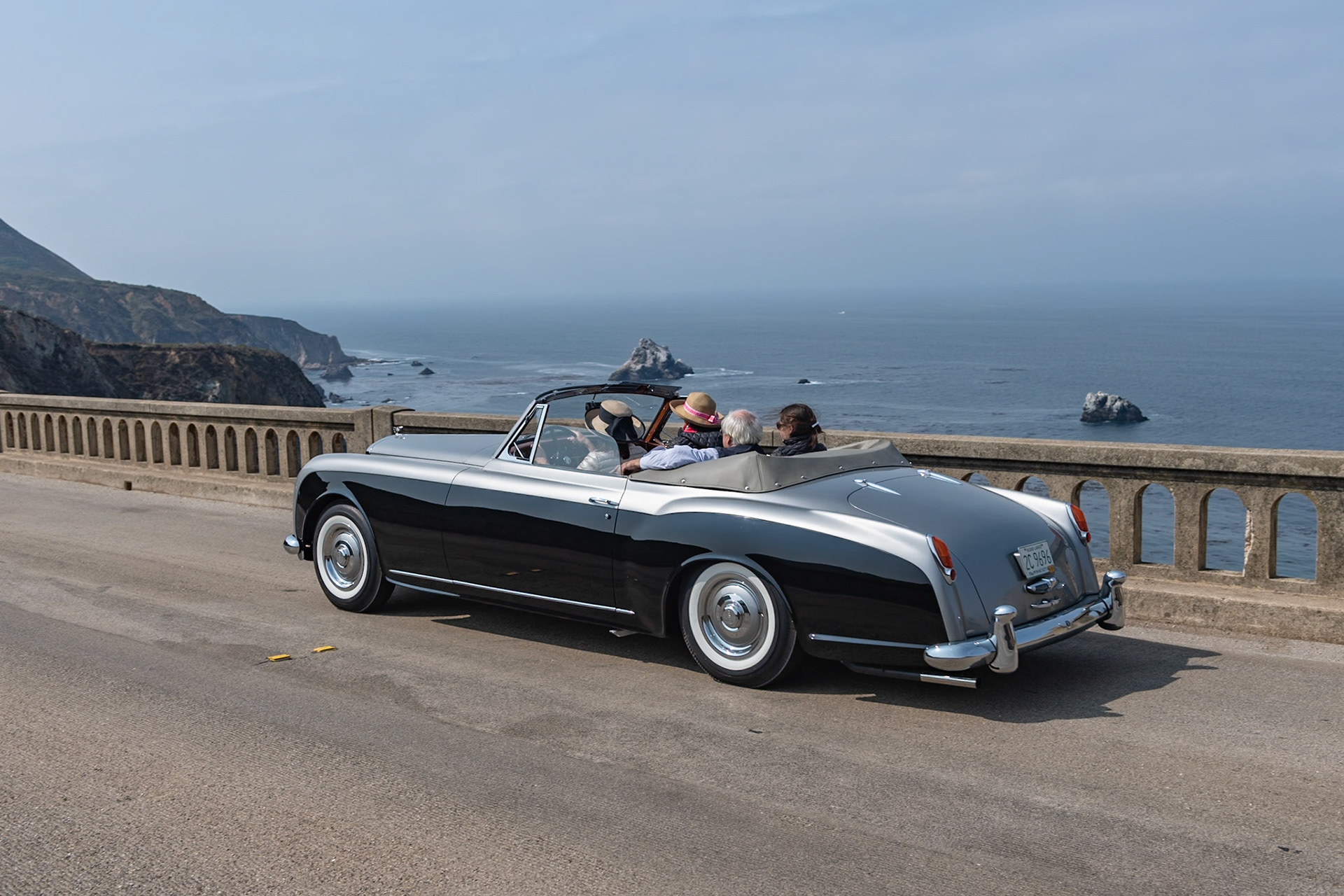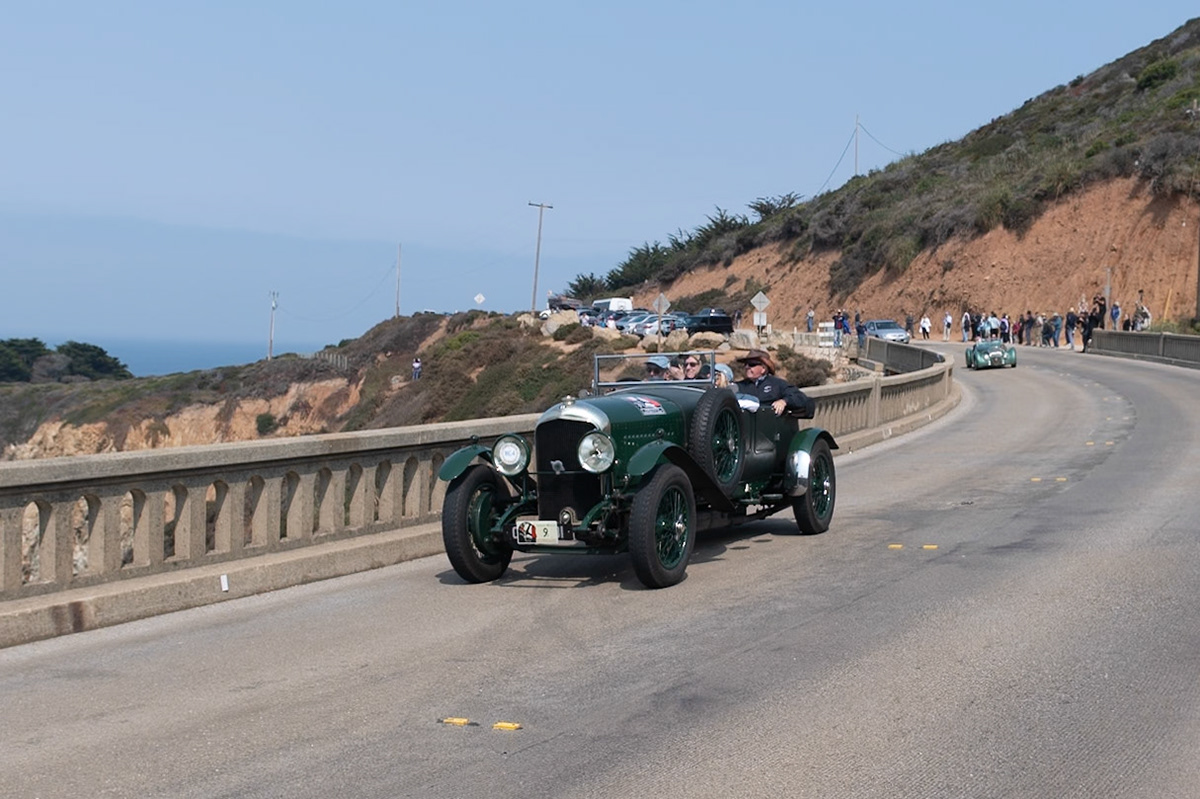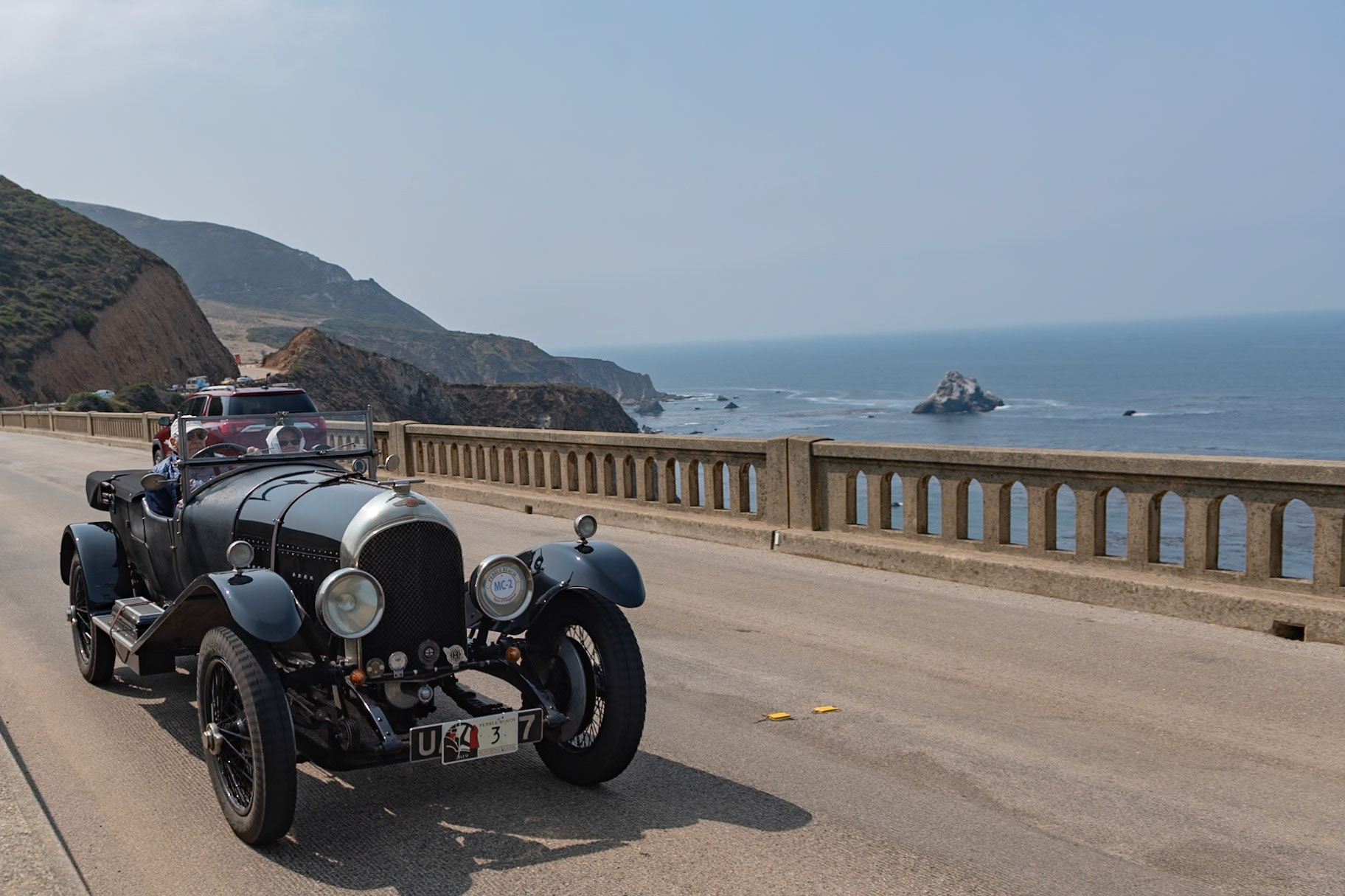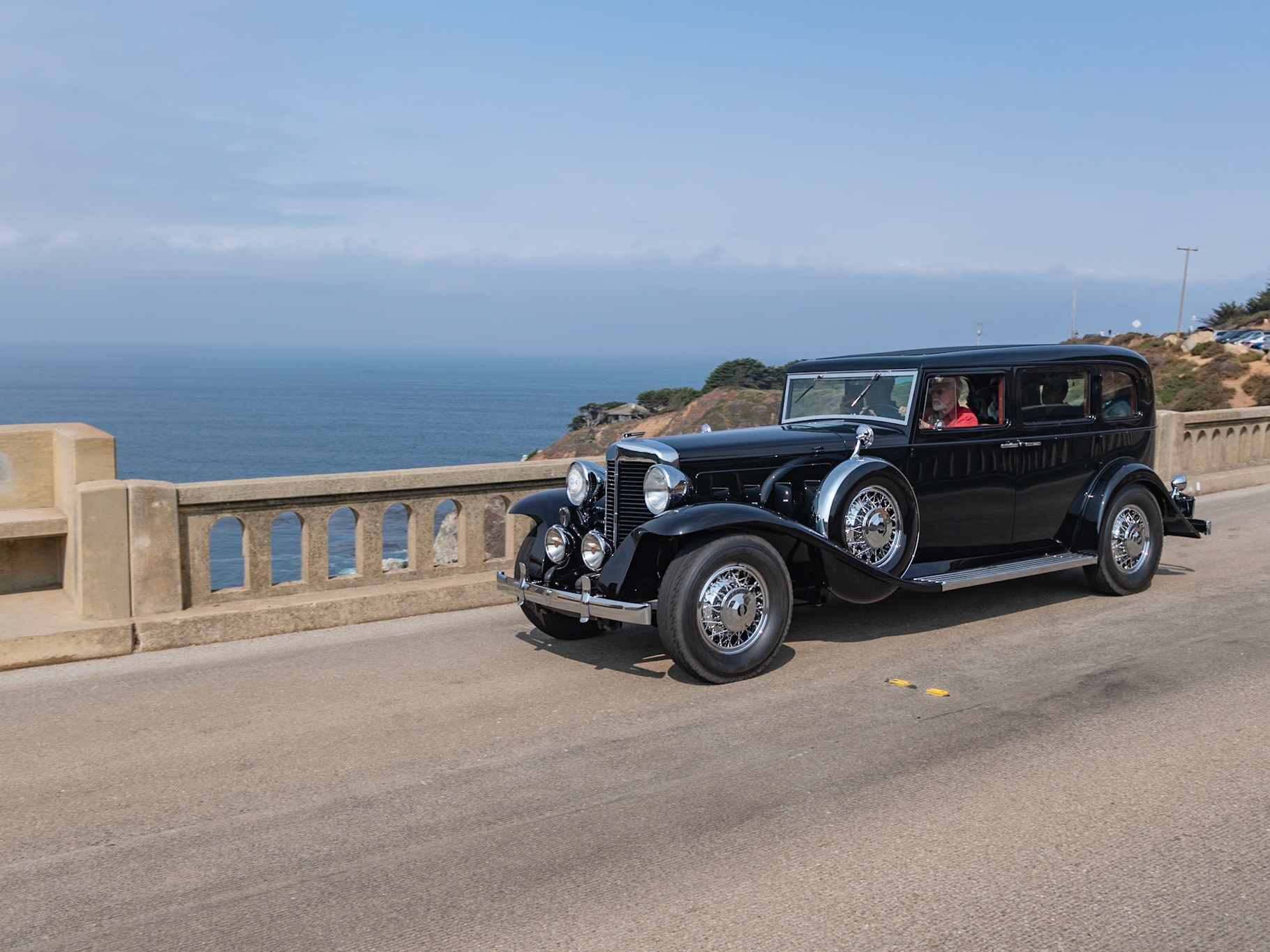
The Bentley S1 followed the R-Type in late 1955 and was one of the era’s most stylish motor cars. The Park Ward Drophead Coupé on this S1 (chassis BC25LDJ) is the work of legendary coachwork designer John Blatchley, famous for the Mulliner-bodied R-Type Continental. It is one of 31 left-hand drive aluminum-bodied drophead coupés by Park Ward, and it was ordered for H.R.H. the Crown Prince Abdullah of Iraq. Unfortunately the prince didn’t get to enjoy his new car as, soon after its delivery, he lost his life in the military coup of 1958. The car was acquired by Mr. Janabi, a Baghdad businessman, in 1968. The car attracted the attention of Saddam Hussein when it appeared in the 1990s film King Ghazi of Iraq, and after Janabi repeatedly refused to sell the car to him, it was forcefully “requisitioned.” In 2006, after the fall of Saddam’s regime, the car was found in his underground garage in Baghdad, having been neglected and badly vandalized. The car has now been restored to its former glory.

The Bentley Speed Six chassis was introduced in 1928 as a more powerful and sporting version of the 6½ Litre known as the Big Six. Bentley built this car for Sir Egbert Cadbury, a member of the Cadbury chocolate family who had served as a pilot in World War I and shot down two Zeppelins on their way to bomb London. He kept the car until 1954, but after a time, he had its original Mulliner saloon body replaced with this Vanden Plas “bobtail” coachwork from another Speed Six. Only four of these distinctive bodies were made by Vanden Plas and three survive. The first was built on a 4½ Litre chassis for the Le Mans Bentley Boy, Bertie Kensington Moir, and was used as a demonstrator at his Bentley dealership. This special Bentley has recently been restored with “new” Rexine fabric made to the exact specification of the original Vanden Plas body.

This car (chassis 3918) is one of the original 50 supercharged 4½ Litre “Blower” Bentleys. It is also one of just three Blowers built by Tim Birkin to Le Mans specifications, with extended bonnet, external Le Mans fuel tank, and team car instrument panel. The car was built for Billy Fiske, the Cresta Run Bob-Sleigh Champion. Fiske was also the first American to join the British RAF in 1939 and he tragically lost his life flying a Hurricane during the Battle of Britain. While in his possession, this car lapped Brooklands’ outer circuit at 121.4 mph. After Fiske, the car was in single ownership for 50 years before changing hands. It has recently undergone a complete restoration by Bentley expert Graham Moss, who reunited the car with its original engine and finished the body in the period-correct Rexine fabric.

Bentley introduced the first production R-Type Continental Fastback chassis in 1952, a year after the prototype OLGA. Despite its name, the two-door Continental was intended principally for the British market; only 43 left-hand drive cars were built for export. This car (chassis BC9C) is one of 208 R-Type Continentals built at the Rolls-Royce factory at Crewe and delivered to H.J. Mulliner to be fitted with this unique Sports Saloon body featuring upswept rear wings with one-piece chrome taillamps and cutaway rear spats. Completed in 1954, the car was delivered to golfer Philip Scrutton, who won the Brabazon Trophy three times in four years and competed in the Walker Cup twice. In May 1955 the car was sold to Stanley Hailwood, father of the motorcycle champion “Mike the Bike.” Stanley showed the car at the Cannes Concours d’Elegance and toured with it in the south of France. It went to Australia in 1968 but returned to England in 2015.

The Bentley S1 followed the R-Type in late 1955 and was one of the era’s most stylish motor cars. The Park Ward Drophead Coupé on this S1 (chassis BC25LDJ) is the work of legendary coachwork designer John Blatchley, famous for the Mulliner-bodied R-Type Continental. It is one of 31 left-hand drive aluminum-bodied drophead coupés by Park Ward, and it was ordered for H.R.H. the Crown Prince Abdullah of Iraq. Unfortunately the prince didn’t get to enjoy his new car as, soon after its delivery, he lost his life in the military coup of 1958. The car was acquired by Mr. Janabi, a Baghdad businessman, in 1968. The car attracted the attention of Saddam Hussein when it appeared in the 1990s film King Ghazi of Iraq, and after Janabi repeatedly refused to sell the car to him, it was forcefully “requisitioned.” In 2006, after the fall of Saddam’s regime, the car was found in his underground garage in Baghdad, having been neglected and badly vandalized. The car has now been restored to its former glory.

This car (chassis 3918) is one of the original 50 supercharged 4½ Litre “Blower” Bentleys. It is also one of just three Blowers built by Tim Birkin to Le Mans specifications, with extended bonnet, external Le Mans fuel tank, and team car instrument panel. The car was built for Billy Fiske, the Cresta Run Bob-Sleigh Champion. Fiske was also the first American to join the British RAF in 1939 and he tragically lost his life flying a Hurricane during the Battle of Britain. While in his possession, this car lapped Brooklands’ outer circuit at 121.4 mph. After Fiske, the car was in single ownership for 50 years before changing hands. It has recently undergone a complete restoration by Bentley expert Graham Moss, who reunited the car with its original engine and finished the body in the period-correct Rexine fabric.

Trevor Tomkins and Nicholas Tomkins, Mill Valley, CA

In late 1927, Bentley added the 4½ Litre model to its successful 3 Litre, and the new car dominated endurance racing. Woolf Barnato and Bernard Rubin drove a 4½ Litre to victory at Le Mans in 1928, the first of three wins by Barnato in the 4½. W. O. Bentley recognized that sporting success sold cars, and between 1927 and 1931, his cars were sold to aspiring “Bentley Boys” and Girls the world over. Most vintage Bentleys have lost their original coachwork but this car is an exception; it is an original, matching numbers 4½ Litre. Ordered by a Mr. M. W. Keefer, it was fitted with Weymann-type coachwork by the North London coachbuilders Harrison & Son. Harrison was one of the smaller coachbuilders at the time, but it produced trucks and buses and also car bodies for Daimler and Rolls-Royce as well as Bentley. This car lived in England until the 1950s, then spent a long period in Australia before coming to the United States.

Bentley introduced the first production R-Type Continental Fastback chassis in 1952, a year after the prototype OLGA. Despite its name, the two-door Continental was intended principally for the British market; only 43 left-hand drive cars were built for export. This car (chassis BC9C) is one of 208 R-Type Continentals built at the Rolls-Royce factory at Crewe and delivered to H.J. Mulliner to be fitted with this unique Sports Saloon body featuring upswept rear wings with one-piece chrome taillamps and cutaway rear spats. Completed in 1954, the car was delivered to golfer Philip Scrutton, who won the Brabazon Trophy three times in four years and competed in the Walker Cup twice. In May 1955 the car was sold to Stanley Hailwood, father of the motorcycle champion “Mike the Bike.” Stanley showed the car at the Cannes Concours d’Elegance and toured with it in the south of France. It went to Australia in 1968 but returned to England in 2015.

The Speed Six Bentley was introduced at the 1928 Olympia Motor Show in London as a more sporting version of the marque’s earlier standard 6½ Litre chassis. The new model caught the public’s eye and imagination after scoring triumphs at Brooklands and Le Mans. The Speed Six had an engine that was uprated with twin SU carburetors, which increased the power to 160 bhp. The most obvious external change was a new radiator and bulkhead with parallel sides, rather than the tapered radiator of the Standard Six, and it was built on an 11'6" wheelbase chassis, rather than the 12'6" wheelbase chassis of the Standard Six. This 1930 Bentley Speed Six (chassis NH2741) bodied by Gurney Nutting was sold to its first owner through the Bentley dealership of Kensington Moir & Straker Ltd. of London. Gurney Nutting bodied 46 Speed Six chassis in total, almost a quarter of the 182 Speed Six that were built by Bentley Motors, but only four Speed Sixes exist today with their original Weymann sports saloon bodies and this is the only Speed Six that retains its original Gurney Nutting coachwork.

Trevor Tomkins and Nicholas Tomkins, Mill Valley, CA

Trevor Tomkins and Nicholas Tomkins, Mill Valley, CA

This is the first of two 4¼ Litre Bentleys built by Gurney Nutting and known as the Rothschild Bentley Sedancas. This car was commissioned for Madame Yvonne Cahen d’Anvers Rothschild, and it bears a strong resemblance to Hispano-Suizas supplied to other members of the famous banking family. But Madame Rothschild canceled the order before the car was finished, so it was sold to William Rhodes-Moorhouse. A keen sportsman, “Willie” represented Great Britain as a ski-jumper in the 1936 Winter Olympics and later served as a fighter pilot with the Royal Air Force, flying Blenheims and Hurricanes with the famous 601 squadron. In fact, he was awarded the Distinguished Flying Cross in July 1940 before being shot down that September. So the car saw little use until after the conflict. The car had several British owners then was acquired by Bentley authority and Pebble Beach Concours Selection Committee Member Peter Hageman, who owned it from 1995 to 2001. Its present owner added the Bentley to his collection in 2012.

This is the first of two 4¼ Litre Bentleys built by Gurney Nutting and known as the Rothschild Bentley Sedancas. This car was commissioned for Madame Yvonne Cahen d’Anvers Rothschild, and it bears a strong resemblance to Hispano-Suizas supplied to other members of the famous banking family. But Madame Rothschild canceled the order before the car was finished, so it was sold to William Rhodes-Moorhouse. A keen sportsman, “Willie” represented Great Britain as a ski-jumper in the 1936 Winter Olympics and later served as a fighter pilot with the Royal Air Force, flying Blenheims and Hurricanes with the famous 601 squadron. In fact, he was awarded the Distinguished Flying Cross in July 1940 before being shot down that September. So the car saw little use until after the conflict. The car had several British owners then was acquired by Bentley authority and Pebble Beach Concours Selection Committee Member Peter Hageman, who owned it from 1995 to 2001. Its present owner added the Bentley to his collection in 2012.

The Bentley S1 Continental was conceived to be an exclusively coachbuilt car. Accordingly, each of 432 S1 Continentals received coachwork from the few remaining coachbuilders that survived World War II. H. J. Mulliner, Hooper and James Young all built a variety of both open and closed bodies, but this drophead coupé is one of just 31 built by Park Ward. Bentley records show that this car (chassis BC91LBG) was delivered at the end of 1956 to Frederick Brewster of Connecticut. He was connected to the famous coachbuilding firm of Brewster & Co., and the family can trace its roots back to Elder William Brewster, who sailed on the Mayflower in 1620. Frederick’s daughters, Susan and Priscilla, inherited the car in 2012 and commissioned a full and complete restoration from Vantage Motorworks to its original specifications in Shell Grey over Black with Black top and Light Grey hides.

The Bentley S1 Continental was conceived to be an exclusively coachbuilt car. Accordingly, each of 432 S1 Continentals received coachwork from the few remaining coachbuilders that survived World War II. H. J. Mulliner, Hooper and James Young all built a variety of both open and closed bodies, but this drophead coupé is one of just 31 built by Park Ward. Bentley records show that this car (chassis BC91LBG) was delivered at the end of 1956 to Frederick Brewster of Connecticut. He was connected to the famous coachbuilding firm of Brewster & Co., and the family can trace its roots back to Elder William Brewster, who sailed on the Mayflower in 1620. Frederick’s daughters, Susan and Priscilla, inherited the car in 2012 and commissioned a full and complete restoration from Vantage Motorworks to its original specifications in Shell Grey over Black with Black top and Light Grey hides.

1962 Bentley S-2 Continental Saloon James Young Michael & Heike BerendesMainz, Germany

1962 Bentley S-2 Continental Saloon James Young Michael & Heike BerendesMainz, Germany

1962 Bentley S-2 Continental Saloon James Young Michael & Heike BerendesMainz, Germany

1925 Bentley 3/4½ Litre Tourer, Vanden Plas Trevor “Monty” Montgomery, Jim RuncimanMalvern, Australia

1925 Bentley 3/4½ Litre Tourer, Vanden Plas Trevor “Monty” Montgomery, Jim RuncimanMalvern, Australia

1929 Bentley 4½ Litre Tourer Vanden Plas Trevor Tomkins, Mike DrennanMill Valley, CA

1929 Bentley 4½ Litre Tourer Vanden Plas Trevor Tomkins, Mike DrennanMill Valley, CA

1929 Bentley 4½ Litre Tourer Vanden Plas Trevor Tomkins, Mike DrennanMill Valley, CA

This Derby-built Bentley 3½ Litre was first displayed by Bentley Motors at the Paris Auto Salon in October 1934 with a body built by Henri Binder. While in Paris, the chassis was purchased by another French coachbuilder, Jean Antem, who was based in nearby Courbevoie. Carrosserie Antem was one of the leading French coachbuilders between the wars. The Bentley was acquired on behalf of amateur racing driver Nicky Embiricos, who ordered the Antem body. The car is one of several Derby Bentleys owned by the famous Greek shipping family. When war was declared in 1939, and just before the fall of France, the car was taken to England to be sold. In 1942, the car was purchased by the Maharaja of Talcher, who loaded it onto a troopship and sailed with it to Calcutta. After several other owners, the car was acquired by its current owner in 1972 and restored to its original color scheme in 2013.

This Derby-built Bentley 3½ Litre was first displayed by Bentley Motors at the Paris Auto Salon in October 1934 with a body built by Henri Binder. While in Paris, the chassis was purchased by another French coachbuilder, Jean Antem, who was based in nearby Courbevoie. Carrosserie Antem was one of the leading French coachbuilders between the wars. The Bentley was acquired on behalf of amateur racing driver Nicky Embiricos, who ordered the Antem body. The car is one of several Derby Bentleys owned by the famous Greek shipping family. When war was declared in 1939, and just before the fall of France, the car was taken to England to be sold. In 1942, the car was purchased by the Maharaja of Talcher, who loaded it onto a troopship and sailed with it to Calcutta. After several other owners, the car was acquired by its current owner in 1972 and restored to its original color scheme in 2013.

This Derby-built Bentley 3½ Litre was first displayed by Bentley Motors at the Paris Auto Salon in October 1934 with a body built by Henri Binder. While in Paris, the chassis was purchased by another French coachbuilder, Jean Antem, who was based in nearby Courbevoie. Carrosserie Antem was one of the leading French coachbuilders between the wars. The Bentley was acquired on behalf of amateur racing driver Nicky Embiricos, who ordered the Antem body. The car is one of several Derby Bentleys owned by the famous Greek shipping family. When war was declared in 1939, and just before the fall of France, the car was taken to England to be sold. In 1942, the car was purchased by the Maharaja of Talcher, who loaded it onto a troopship and sailed with it to Calcutta. After several other owners, the car was acquired by its current owner in 1972 and restored to its original color scheme in 2013.

The Bentley S1 Continental was conceived to be an exclusively coachbuilt car. Accordingly, each of 432 S1 Continentals received coachwork from the few remaining coachbuilders that survived World War II. H. J. Mulliner, Hooper and James Young all built a variety of both open and closed bodies, but this drophead coupé is one of just 31 built by Park Ward. Bentley records show that this car (chassis BC91LBG) was delivered at the end of 1956 to Frederick Brewster of Connecticut. He was connected to the famous coachbuilding firm of Brewster & Co., and the family can trace its roots back to Elder William Brewster, who sailed on the Mayflower in 1620. Frederick’s daughters, Susan and Priscilla, inherited the car in 2012 and commissioned a full and complete restoration from Vantage Motorworks to its original specifications in Shell Grey over Black with Black top and Light Grey hides.

This is the first of two 4¼ Litre Bentleys built by Gurney Nutting and known as the Rothschild Bentley Sedancas. This car was commissioned for Madame Yvonne Cahen d’Anvers Rothschild, and it bears a strong resemblance to Hispano-Suizas supplied to other members of the famous banking family. But Madame Rothschild canceled the order before the car was finished, so it was sold to William Rhodes-Moorhouse. A keen sportsman, “Willie” represented Great Britain as a ski-jumper in the 1936 Winter Olympics and later served as a fighter pilot with the Royal Air Force, flying Blenheims and Hurricanes with the famous 601 squadron. In fact, he was awarded the Distinguished Flying Cross in July 1940 before being shot down that September. So the car saw little use until after the conflict. The car had several British owners then was acquired by Bentley authority and Pebble Beach Concours Selection Committee Member Peter Hageman, who owned it from 1995 to 2001. Its present owner added the Bentley to his collection in 2012.

1926 Bentley 3 Litre Vanden Plas TourerFrank & Janet AlloccaChester, NJ

1962 Bentley S-2 Continental Saloon James Young Michael & Heike BerendesMainz, Germany

1925 Bentley 3/4½ Litre Tourer, Vanden Plas Trevor “Monty” Montgomery, Jim RuncimanMalvern, Australia

1929 Bentley 4½ Litre Tourer Vanden Plas Trevor Tomkins, Mike DrennanMill Valley, CA


